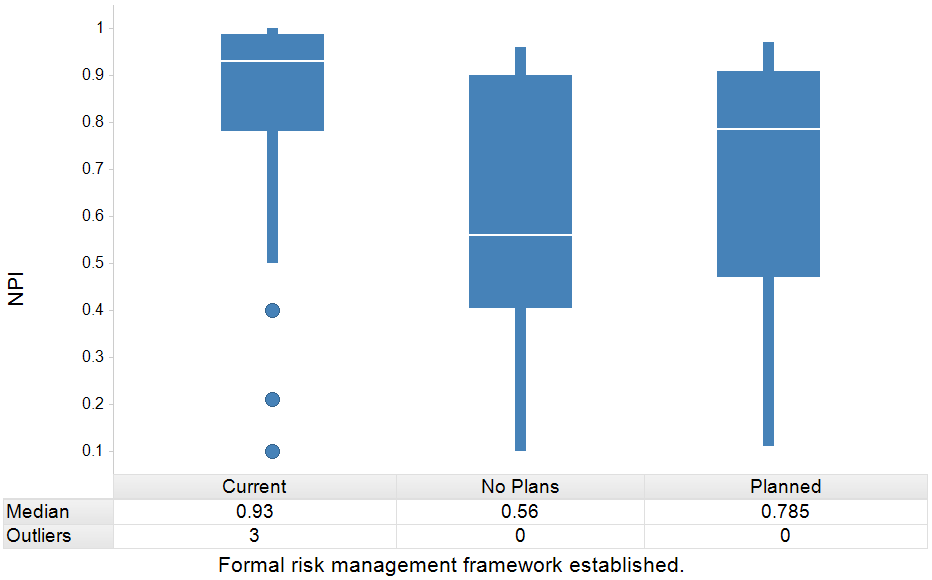Industrial companies are focused on a wide range of objectives today that are highly dependent on things like industry, company size, maturity, regulatory burden, and others. But, from a financial perspective, one that looms large and is nearly universal is growing revenue.
A quick look at our Manufacturing Operations Management (MOM) survey reveals that, among more than 500 industrial respondents coming from a range of industries, the top financial objective was to grow revenue, as this was the top response for Discrete (57%), Batch (53%), and Process (50%) industries. To add a little perspective, no other response topped 20% for this question.
Clearly, increasing revenue has all the makings of the elephant in the room. And there are obviously a number of ways to accomplish this goal. But one important and sometimes overlooked way leading companies are doing this today is by effectively mitigating and managing operational risk by establishing a framework that involves formal processes and supporting software.
In this post, we’ll explore why developing this Operational Risk Management (ORM) framework is crucial in managing diverse operational risks and important in elevating key operational metrics that feed into that holy grail of increased revenue.
The Operational Risk Management Framework
The ORM framework involves developing a standardized set of processes across the enterprise to handle the uniqueness and complexity of operational risks. The steps include:
 Identify: This involves establishing an overall risk register that includes hazards, proactive controls, adverse events, reactive controls, and consequences. Important to classify hazard categories across people, processes, assets, suppliers, and products.
Identify: This involves establishing an overall risk register that includes hazards, proactive controls, adverse events, reactive controls, and consequences. Important to classify hazard categories across people, processes, assets, suppliers, and products.
- Assess: Here companies establish the likelihood of specific adverse events occurring based on existing hazards and established controls, as well as the impact that would occur if an adverse event came to pass. By quantifying this likelihood and impact, heat maps and other prioritization tools can be established.
- Monitor: ORM must be vigilantly monitored for changes on the ground as they occur.
- Respond: The first three stages of ORM are useless without the fourth. First and foremost, companies should focus on the proactive, which means improving controls or transferring risk in one way or another. Great examples include enhancing Environment, Health and Safety (EHS), adopting new safety systems, or becoming more predictive in maintenance practices.
The Role of ORM Software
Managing and applying the ORM framework to the enterprise is a challenging and involved task, and one of the quickest ways to lose momentum is to attempt to manage all the variables through spreadsheets and disconnected systems. It’s simply too costly and inefficient to be sustainably effective in today’s operations—particularly in inherently risky industries like process manufacturing.
Generally delivered as a component of EHS software, Governance, Risk & Compliance (GRC), or possibly Enterprise Quality Management Software (EQMS) deployments, ORM software automates, centralizes, and standardizes the ORM framework and provides critical analytical and intelligence tools to support quicker, and more informed decisions around risk, operations and financial performance. Relating to the framework summary above, ORM software offers the following cited benefits:
- Change management: Every time a company experiences a change in personnel, process, or assets, the risk profile needs to be updated and communicated. Automating this through ORM software eliminates the time and resource-consuming nature of doing this manually and, equally important, eliminates human error.
- Integration and data collection: Risk-related metrics and KPIs are sourced from many enterprise systems, including EHS, EAM, ERP, EQMS, and others. ORM software collects and integrates this information from these data sources, eliminating costly and time-consuming manual collection.
- Dashboarding and analytics: as an extension of the previous two points, ORM software’s strong integration capabilities offer a level of risk management analysis that is far deeper and more accurate than can be delivered by manual processes and spreadsheets. The dashboards provided by ORM can be tailored and delivered to all roles, increasing visibility and awareness of how individual decisions impact risk.
The Impact of Formal Risk Management Framework on NPI
Now that we’ve established the particulars of structuring a formal ORM framework, let’s take a look at how successful New Product Introductions (NPI), a metric that has considerable impact on revenue, is impacted. Looking at the box plot below we can see a very notable difference in NPI among survey respondents, as those with a formal risk management framework established recorded a median NPI of 93% as compared to 56% for companies with no plans for ORM implementation and 79% for those that planned to establish ORM but were yet to have it in place.

Particularly in highly competitive markets, this puts the companies that lack an ORM framework at a great disadvantage.
To learn more details and benefits of formal ORM processes and supporting software technologies, click below to read our report, "Driving Financial Performance with Operational Risk Management."